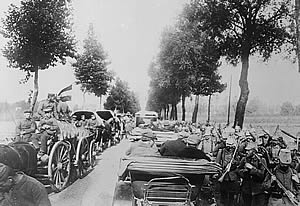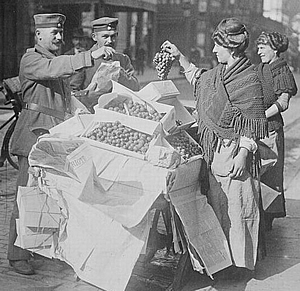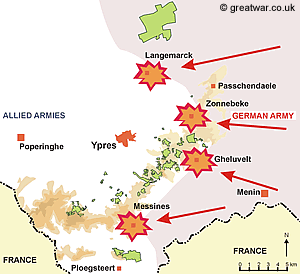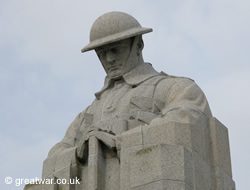Battles of the Ypres Salient: Introduction
The Great War Arrives at Ypres

|
According to local accounts, the first contact for the people of Ypres with the First World War was the arrival of thousands of German troops on 7 October 1914. They began to enter the town from the south-east along the road from Menin through the Menin Gate (Menenpoort) and from the south through the Lille Gate (Rijselpoort). Scouting parties advanced north and west beyond Ypres in the directions of Boesinghe, Vlamertinghe and Elverdinghe. By 9pm the town, its streets and market square were packed full of horses and riders, soldiers, carts, carriages, cars, field kitchens and guns. The local accounts reckon on about 10,000 troops. Soldiers were billeted for the night in the halls of the Cloth Hall, in schools, the army barracks, the waiting rooms at the railway station and in houses with the local people. The mayor, Mr Colaert, advised the people of Ypres to stay calm and remain in their homes.

|
The shops were crammed full of German soldiers. By way of payment some offered German coins, some had paper notes. Others gave pre-printed coupons to the shopkeepers or locals for food and clothes. There were stories of damage to the railway station, stealing from local peoples' homes and drinking. The bakers were ordered to have 8,000 bread rolls baked and ready for 8.30am the next morning, 8 October, to distribute to the troops. Hay, straw and oats were requisitioned and the town's coffers were emptied of 62,000 Francs. Horses and wagons were requisitioned and paid for with coupons. Anyone in receipt of a coupon as payment was, however, unlikely ever to receive payment from the German Army because the next day, 8 October, the Germans started to move out of the town from about midday. The soldiers on foot went in the direction of Dickebusch. The cavalry went in the direction of Vlamertinghe. They were never to return.
The French and British Armies Enter Ypres
A few days later on 13 October troops of the French and British Armies arrived in Ypres, passing through the town to the east and taking up defensive positions to hold up the advance of the German Army. From that time the town was to become embroiled in war for the next four years. Almost every building would be razed to the ground by November 1918.
The first major battles to take place in the area of Ypres took place from October 1914. However, during the fierce fighting in the autumn of 1914 the German Army was unable to capture Ypres. The French and British forces had denied the German commanders a route across Belgium to the French coastal ports of Calais and Dunkirk.
Creation of the Ypres Salient

|
From January 1915 a stalemate situation existed between the Allied and the German armies. The Allies sat firm in a defensive semi-circular Front Line running from the northeast, east and southeast of Ypres. The occupation of this ground east of Ypres pushed a bulge, called a “salient” in military terms, into the German Front Line here. To the advantage of the Allies it forced the Germans to provide extra manpower to hold a longer section of Front Line. However, a serious Allied disadvantage here was that the Germans had knowingly secured relatively good positions along the edges of this salient. From the south of Ypres there is a naturally occuring spur of high ground which continues around the eastern side of the town of Ypres. It runs generally in a north-easterly direction creating a ridge of slightly higher ground from Messines in the south to Passchendaele in the north (indicated in brown on the map).
The Allied determination to protect Ypres at all costs left them in a difficult defensive position. The Allied forces found themselves defending a saucer-shaped salient of some 24 square kilometres. The town of Ypres was to the rear of their defensive Front Line in the centre of the saucer. The German Army, however, was digging into selected good defensive positions on the slightly higher ground around the rim of the saucer. The battlegrounds here became known as the “Ypres Salient” for this reason.
The advantages of the rise in ground on the naturally occuring spur becomes clear when visiting these battlefields. It is not only the crucial advantage of the view across the enemy's positions and rear areas. But also the daily life of the soldier is greatly affected by the better drainage of the positions located on higher ground. The area of Belgian Flanders around Ypres is generally low-lying, it consists of heavy, waterlogged, clay-based soil, has a damp coastal climate and is prone to flooding.
Next >> Ypres Salient Battles 1914
Further Reading

A Storm in Flanders: Triumph and Tragedy on the Western Front (paperback)
by Winston Groom
Focusing mainly on the British experience in the Ypres Salient between 1914-1918, this book gives an accessible account of the story of the Ypres Salient from the generals commanding in their chateaus to the soldiers in the trenches. A gripping read.
Related Topic

|
Visiting the Ypres Salient Battlefields
Acknowledgements
(1) Despatch by Field-Marshal Sir John French, published in the Second Supplement of The London Gazette issue 28989 of Friday 27th November, 1914, the Supplement being dated 30 November, 1914, pages 10121-10132.
GWPDA Photographs with grateful thanks to the Great War Primary Document Archive: Photos of the Great War.
Hanslian sketch Sketch by Dr R Hanslian in Königlich Preussisches Reserve-Infanterie-Regiment 213, by Max Tiessen, J J Augustin, Hamburg-New York, 1937, p. 186.

